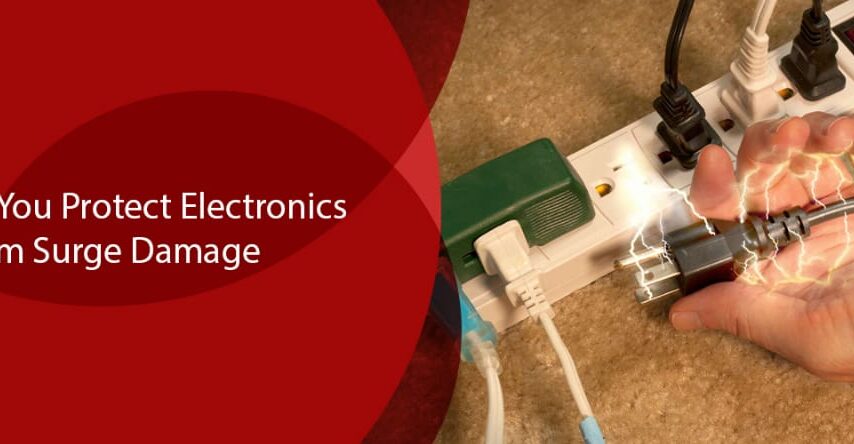An electric surge ability to damage electronic devices can be anything from minor repairs to completely replacing the devices altogether. What really is an electrical surge? You know those brief seconds of where the lights suddenly get too bright? That is an electrical surge – they are unexpected increases in the voltage but usually last for a few seconds. And those few seconds can mean anything depending on how lucky you are.
Causes of Electrical Surges
To understand how you can protect your home electronics from the damage caused by power surges, you must first understand what causes these power surges to be prepared for the next time you can be.
1. Lightning
One of the most common causes of electrical surges is lightning. Areas across the country that experience more lightning tend to struggle with more electrical surges, which can be quite damaging to any electronics present in the home—even something as small as a light bulb or as crucial as electrical switchboards. Lightning makes its way into our homes through electrical lines and cables, and the voltage it carries is by far the highest compared to any other source of electrical surges.
2. Faulty Wiring
Wiring can be old or faulty whether it is within the walls or even of any exposed wiring. Faulty wires can trigger electrical surges but how can you spot one is the question. Well, if you were to ever smell a burning odor or see burn marks around a power outlet, that is the result of an electrical surge – and if there is any device plugged into that outlet then chances are it may have caused damage to it to some extent. Another tell-tale sign is a slight buzzing sound, and if there is no annoying fly around then it’s definitely coming from the power outlet.
3. Power Blackouts
Power blackouts aren’t exactly common across the country but when they do occur, there is almost always some device or the other that seems to suffer because of it. Why is that? It is because when power companies turn the power back on to the grid, there is an excessive amount of voltage that is released and of course it flows directly into power lines that go straight to our homes and buildings.
How to Protect Your Home Electronics from Electrical Surges
There isn’t a way to exactly prevent electrical surges from occurring, but there are ways for you to protect your home electronics, however you can. Here is how.
1. Surge Coverage Plans
Surge coverage plans are like insurance except for your home electronics. Anything from smart devices, laptops, gaming consoles and TVs, to air conditioners, refrigerators and other kitchen appliances – even washing machines and dryers too. For costs as low as $8.99 monthly by FirstEnergy for instance, you can get coverage for the repair and replacement of a whole list of electronics in your home. Better than ending up in bills worth hundreds of dollars, right?
With no hidden fees or deductibles, or anything external to install, surge coverage plans are your best bet at having absolute protection for electronic devices in your home. That even at almost a very minimal expense.
2. Surge Protectors
Surge protects on the other hand are external devices, that usually resemble external power cords with multiple outlets, or even an external plug with multiple outlets. They are however more expensive than ordinary power cords and multi-plugs, but that is because these come with built-in circuit breakers that are meant to ground the extra voltage passing into the device in the event of an electrical surge. That means it only lets the required amount pass through onto the devices that are plugged into the outlets.
There is one thing that you must keep in mind however. The lifespan of surge protectors ideally depends on the frequent occurrence of electrical surges. The more frequent the power surges in your home, the earlier you may need to replace your surge protectors with new ones.
3. Unplug Your Electronics When Not In Use
Not exactly a device or a plan to protect your home electronics, but unplugging your electronics when they are not in use is a good habit, and can go a long way in keeping them from getting damaged from electrical surges.
Unplugging your refrigerators for instance is obviously not the option, but other appliances like your TV, gaming console if there is one, laptop and phone chargers, lamps, microwaves and toasters can be unplugged when they are not in use. Putting in the habit of doing this at the end of your day or just when you’re not using them will actually prevent them from damage in the event that electrical surges occur in the middle of the night while you’re sleeping, or while you’re away from home. Better to be safe than land up in repairment bills, right?
Now that you know what causes electrical surges, and what are the ways to prevent them from damaging your home electronics, you’ll probably be prepared the next time around there is a predicted thunderstorm in your area or to take precautions every morning as you head out for work.
To look up details of a great Surge Coverage Plan, you can check out FirstEnergy’s Surge Coverage plan at www.firstenergyhome.com. You won’t be disappointed!



